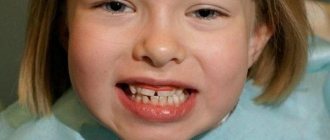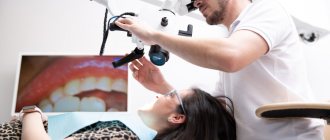“Mom, I want a big chocolate!” - the three-year-old child bursts into loud hysterics throughout the store. The blushing mother, embarrassed in front of the public, hastily buys what she needs. The situation repeats itself constantly and is aggravated, moreover, by the love of adults who strive to treat the baby with something tasty. And after a while, the baby begins to complain of toothache... But sweets are only one of the reasons why caries occurs in children’s baby teeth; Olga Dzedzits, a leading specialist in pediatric dentistry at Inpromed in Moscow, told us about other possible reasons.
How to identify milk caries?
It is quite simple to identify caries in young and older children. White or brown spots appear on the teeth, a painful reaction to hot and cold is observed, and the child may develop bad breath. When these first symptoms of caries appear, it is already worth sounding the alarm, since the carious process is developing very rapidly. It is characterized by almost instantaneous damage to several teeth, and if measures are not taken, the entire dentition may be affected. Of course, it is often difficult for a child to articulate that his baby tooth hurts. He may refuse to eat or chew on only one side. This should also alert parents and encourage them to take their child to pediatric dentistry.
Features of bottle caries
Bottle caries in a child under 1 year of age is one of the most common types of carious lesions in primary teeth. It occurs when young children are bottle-fed before bed. As a result, food remains in the oral cavity, which bacteria actively process while the child sleeps.
There is a myth that bottle caries cannot occur if the child is fed natural products - milk, kefir, juice without sugar. But cariogenic bacteria feed not only on artificial, but also on “natural” sugars - lactose, fructose, so the “naturalness” of children’s products does not reduce the risk of developing bottle caries.
What are the causes of caries in primary teeth?
There are more reasons for caries of baby teeth in children than meets the eye. This includes improper oral hygiene, sharing cutlery with adults who have caries, and much more. However, the main causes of occurrence are the influence of consumed carbohydrates that destroy the tooth, accidental infection from a carrier of a carious infection, a genetic factor, the immaturity of the children's skeletal system, and improper use of pacifiers and nipples.
- Of course, the main and most common cause of caries in primary teeth in children is poor oral hygiene and the influence of sweets. According to statistics, caries develops in young children in 73% of cases. Sucrose, glucose and fructose are the acids that are formed during the fermentation of carbohydrates and lead to the destruction of enamel. Immediately after ingestion of carbohydrates, the pH of saliva decreases from 6 to 4, and pathogenic bacteria settle in food debris that is not cleaned from the teeth.
- Remember the children's saying “from mouth to mouth you get a germ”? It turns out that she is not so far from the truth. The fact is that caries is an infection, an infection. That is, a loving parent, being a potential carrier of carious microbes, does not even suspect that by kissing his baby or sharing dinner with him, he can personally infect his child!
- Another reason why caries may occur on baby teeth is genetic. Teeth begin to form during the prenatal period, in the first trimester of pregnancy. Therefore, smoking by a negligent parent, her illnesses suffered during this period, or taking medications can lead to disruption of the proper development of the child’s teeth.
- Childhood caries of primary teeth may be associated with the following factor: children’s teeth have a low degree of mineralization and erupt “immature”, and only then “mature” in the oral cavity. Final mineralization lasts for one and a half to two years for baby teeth and about three years for permanent ones. Pediatric dentists call such periods of “maturation” the most susceptible to caries. Therefore, the reasons why caries occurs in primary teeth at an early age may also be chronic diseases, the effects of medications, the composition of saliva and the fluoride content in water and food.
- Another cause of caries of primary teeth in young children is improper use of pacifiers. A baby who falls asleep with a bottle in his mouth runs the risk of getting caries on his front teeth, so-called bottle caries. In this case, prolonged contact of the sweet liquid with the teeth leads to caries of all front teeth. In this case, the disease spreads around the entire visible part of the tooth along the perimeter.
As you can see, there are more than enough reasons for the appearance of childhood caries in baby teeth. But they all boil down, as a rule, to demineralization of teeth and destruction of hard tissues. Characteristic changes occurring in teeth can only be diagnosed by a dentist. Further treatment will depend on how severe the caries has developed. What are the stages of development of caries in primary teeth?
Other causes of enamel darkening in children
Rotten baby teeth in a child look different in the photo. Usually these are black spots, lumpy enamel, deformed crowns - unpleasant, ugly, even creepy. But an unaesthetic appearance does not always indicate rotting. Sometimes the reasons lie in other diagnoses or pathologies:
- black plaque;
- enamel hypoplasia;
- abnormalities in tooth shape.
Black plaque - stains on baby teeth
Dark spots on teeth are not always tooth decay. It could also be:
- Priestley's plaque - appears due to the increased activity of certain bacteria that secrete a black pigment. The defect is aesthetic, but dentists advise cleaning the enamel from plaque, since it can prevent caries or other dental diseases.
- Dark deposits due to taking iron supplements are an aesthetic problem, which professional cleaning helps to cope with.
Dark pigmentation is also caused by dysbiosis, lack of calcium, and taking antibiotics. Plaque is removed using gentle dental cleaning methods, returning the enamel to its natural whiteness.
Enamel hypoplasia and tooth shape abnormalities
Hypoplasia manifests itself as a change in the structure and color of the enamel and is not a carious lesion. Is it congenital or acquired? In the case of systemic hypoplasia, the shape of the dentition units may also be affected. Externally, the pathology manifests itself as:
- an altered line of the tooth edge is a natural deformation, and not due to rotten teeth;
- barrel-shaped crowns, cone-shaped - due to changes in the tooth at the dentin level;
- spots on the tooth surface of different sizes and shades - altered enamel thickness, insufficiently developed tissues.
For isolated manifestations, hypoplasia is not treated. In case of severe defects in baby teeth, the doctor will suggest remineralization and filling of the affected areas.
Stages of caries of primary teeth
Dentists distinguish the following stages of caries of primary teeth in children:
- Elementary;
- Surface;
- Average;
- Deep;
Initial caries of primary teeth
Initial caries of baby teeth can be recognized as follows: white spots of different shapes and sizes appear on the enamel, but there is no pain. In an “advanced” case, the initial caries progresses - the spots darken, becoming brown and then black.
Superficial caries of primary teeth
With superficial caries of primary teeth, the dental tissue defect is located within the enamel, and the carious cavity can be either light or dark. However, in this case, pain occurs when the tooth comes into contact with sweet, sour or salty foods. In this case, treatment of the baby tooth and filling of the cavity is already required.
Average caries of primary teeth
Average caries of primary teeth affects the enamel and internal dental tissue, dentin. In addition to the unpleasant sensations from sweet, sour and salty, pain from hot and cold is added. In this case, just as with superficial caries of primary teeth, filling is necessary.
Deep caries of baby teeth
With deep caries of primary teeth, the enamel and a significant part of the dentin are affected. If treatment is not carried out at this stage, then caries can affect the pulp of the tooth and then reach the root, often causing a cyst in baby teeth. Here you just need to see a doctor before the infection goes further. In this case, severe caries of primary teeth and its treatment will depend on how deep the caries has spread.
Can teeth turn black not due to caries?
In very rare cases, teenagers may experience darker tooth color if their daily diet includes a lot of soy sauce, coffee, tea, potatoes, or drugs containing fructose. However, such “darkness” is not at all similar to carious lesions and is easy to distinguish.
Do rotten teeth need to be treated?
Undoubtedly. Remember: the opinion that there is no need to treat baby teeth “because they will fall out anyway” is fundamentally wrong and even criminal. Firstly, caries in baby teeth spreads very rapidly: a couple of months ago the child simply had rotten teeth, and today he is already screaming and crying from pulpitis.
Secondly, untreated caries of a baby tooth can cause inflammation of the soft tissues, the appearance of an abscess, as well as such serious consequences as:
- Sepsis;
- Meningitis;
- Damage to large blood vessels in the neck area;
- Otitis;
- Sinusitis;
- Stomach pain, intestinal disorders, stool disorders and other gastrointestinal diseases.
Thirdly, advanced caries and tooth decay can lead to premature loss of a baby tooth, and subsequently to disruption of the even dentition of molars. Don’t forget that a rotten baby tooth can “infect” a molar tooth with caries.
Don’t forget about children’s complexes: rotten teeth look unsightly and cause significant discomfort to the baby.
How to spot rotting at an early stage?
In order not to go through all the horrors of treating rotten teeth with your beloved daughter or son, be able to recognize the first signs of caries in time:
- The characteristic “rotten” odor from a child’s mouth indicates the presence of cavities.
- Small yellowish spots on the teeth are the first stage of caries.
- A child’s complaints about discomfort when drinking cold, hot and sweet drinks and foods indicate thinning of the enamel.
- The characteristic black spots on the teeth are caries that need to be treated.
Do not forget that it is better to treat caries at an early stage, because it will be much more difficult to eliminate the problem of rotten teeth later.
How to cure rotten teeth?
To cure rotten teeth in a child means taking the baby to the dentist. If the baby’s teeth have already turned black, it is useless to treat them with folk remedies. A variety of balms, rinses and masks can only slow down caries.
An experienced dentist treats rotten teeth in children in stages:
- The doctor examines the oral cavity, identifies areas of caries and inflammation of the gums, and, if necessary, sends the child for an x-ray.
- Teeth are cleaned and caries is treated. If lesions have been identified in several teeth, the doctor draws up a treatment regimen. Milk teeth that cannot be cured are removed.
- To disinfect affected gums, the doctor may prescribe special rinses with herbal decoctions; in rare cases, antibiotics are prescribed to destroy the infection.
Parents should not forget that it is not enough to just cure rotten teeth. It is important to eliminate the cause of caries, otherwise in a couple of months the baby will end up in the dentist's chair again. For example, if the doctor said that the cause of caries lies in the gastrointestinal tract, it is important to visit a gastroenterologist with your child. If the teeth begin to rot because the baby is leaning on candy and soda, reconsider the diet.
There are alternative ways to treat teeth that are slightly affected by caries:
- Remineralization. The dentist strengthens the surface of the teeth with a special mineral composition.
- Silvering. If the child does not allow a filling to be placed, and the tooth is not severely affected by caries, the doctor can strengthen the damaged surface with a solution of silver nitrate.
- Laser therapy. In rare cases, shallow caries can be treated with a laser.
- Deep fluoridation is effective for minor enamel damage. After this procedure, the teeth are saturated with useful minerals for a long time.
- Ozonation for mild caries can clean the rotten row from pathogenic microorganisms.
How to prevent the appearance of rotten baby teeth?
To prevent the child’s teeth from rotting and the dental drill from marring the joyful moments of childhood, it is important to carry out proper caries prevention.
1. Be attentive to your baby
Examine your child’s teeth every two to three days and if characteristic carious cavities appear, immediately make an appointment for the baby to see a doctor.
2. Visit your dentist regularly
Even if you have not noticed any changes in your child’s oral cavity, be sure to take him to the doctor on a preventive basis. The pediatric dentist should be visited twice a year. An experienced specialist can even notice the beginning of caries, which appears as a light spot on the tooth. If caries is detected in a timely manner at an early stage, the doctor can slow down or stop its development using an enamel remineralization procedure.
It is recommended to visit the dentist in the morning, when the baby is alert and calm, and most importantly, has not yet had time to “work up” himself with fears.
3. Strengthen your enamel
Of course, the baby does not need to take antibiotics and anti-inflammatory drugs without a doctor’s prescription. However, you can completely strengthen your child’s enamel with natural ingredients, for example, rinse the mouth with herbal decoctions - oak bark, sage, calendula. These herbs have excellent anti-inflammatory, calming effects.
4. Watch your diet
Believe me, kids in adolescence and young adulthood will have time to eat plenty of chips and drink soda. But in early childhood, you can completely control the diet of your kids. Make sure that your child does not consume a lot of sweets and sours, give the baby more vegetables and fruits - fresh fruits are magic boxes of vitamins and help to naturally cleanse teeth. And, of course, give your child more milk, cottage cheese, kefir and other goodies from cows and goats.
How to properly brush baby teeth?
Teaching a child to take care of his teeth from childhood means ensuring him a happy adolescence and youth without toothache. And caring for your teeth means, first of all, proper brushing. Until the age of 3, it is better to help the child with this procedure, but after three, you can trust the child to brush his teeth on his own.
Remember:
- Teeth need to be brushed from top to bottom - this is the only way to remove the plaque that has formed.
- You need to brush your teeth for at least 2 minutes. Try placing an hourglass in your baby's bathroom, which will teach him to carry out the procedure for a long time. After finishing cleaning, rinse your mouth.
- Children, like adults, should brush their teeth twice a day - morning and evening, before bed. It is important to rinse your mouth after every meal.
To make the process of brushing teeth enjoyable for your baby, it is important to carefully choose toothpaste. For example, ASEPTA BABY gel toothpaste can be used for babies from 0 to 3 years old. The soft gel gently cares for your child's teeth and gums without damaging them. The natural components of the paste provide protection against caries and inflammatory processes in the oral cavity; the bright taste of “tutti-fruiti” makes cleaning a delicious adventure. But the main thing is that “ASEPTA BABY” does not contain abrasives, fluorine, parabens, or sodium lauryl sulfate.
We hope our recommendations for caring for children's teeth and caries treatment will be useful to you. And rotten teeth will never bother either kids or their parents.
Is caries treated in baby teeth?
Is it necessary to treat caries on baby teeth? This question still remains open for some parents. Even knowing that the child has caries, they are in no hurry to see a doctor, thinking as follows: “the milk teeth will fall out anyway.” Such judgments are absurd, because infected baby teeth will lead to complications in the growth of permanent teeth or provoke an exacerbation of other diseases in the baby’s body. One way or another, you will have to remove the baby tooth ahead of time. Caries in pediatric dentistry is considered one of the most common diseases, so both parents and specialists should ask the question “why is it necessary to treat caries of primary teeth?” Dentists believe that treatment of caries in a baby tooth will preserve it until the “arrival” of the molars.
Bad teeth in a child: how to treat
Decay of baby teeth can be stopped. Especially if the parents quickly assessed the threat and brought the child to the children's dental clinic. Treatment options are different:
Remineralization of tooth enamel
The doctor will apply a special gel to the baby teeth, which contains minerals to strengthen the teeth. Usually it is calcium, phosphorus, fluorine. The substances will restore the enamel structure at an early stage of destruction, but if the teeth are already rotting, the dentist will select a different treatment.
Sealing
Cleaning out carious cavities and then installing a filling. The preparation method is selected according to the patient’s age. Modern dental clinics treat teeth without a drill - using the ICON method, as well as using classical methods.
Ozonation of teeth
A method of disinfecting destroyed cavities followed by filling, when ozone is used to eliminate pathogenic microflora. The treatment has proven itself to work with children's rotten teeth, but is only suitable for moderate decay.
Laser therapy
The disinfectant effect of a laser beam is an excellent way to disinfect a small cavity and remove bacterial microorganisms in the mouth of a young patient. Suitable for the treatment of moderate caries of primary teeth.
Removal
A radical method of dealing with rotten teeth of a child. Used when it is impossible to carry out therapy and save teeth.
Rodikova Tatyana
When parents are interested in why their child has bad teeth, I first of all ask about nutrition. Almost all children today eat sweets, chips, and drink soda without restrictions. Of course, this negatively affects the teeth. The second common reason is heredity. Congenital diseases and medications are less likely to damage teeth.
Treatment of caries of primary teeth in children
If the doctor finds that a child has incipient caries, then most likely, treatment of baby teeth will not be required. The specialist will protect the enamel from further destruction using a painless and effective procedure - applying fluoride varnish or a silver fluoride compound. Then, when the baby gets permanent teeth, the dentist can seal the fissures - the depressions between the elevations of the tooth - which will prevent the occurrence of bacterial plaque that destroys the enamel. If caries progresses, you can no longer do without filling. The doctor will quickly and almost painlessly remove the affected tissue and hermetically seal the tooth. Otherwise, caries can develop into pulpitis in a child, and then into periodontitis.
Stages of treatment of caries of primary teeth
- Before administering anesthesia, the doctor must numb the injection site using special gels or spray. Moreover, the content of the anesthetic component should be minimal. Anesthesia is, as a rule, carried out only in cases where pulp removal is required - that is, with medium and deep caries of primary teeth.
- It is advisable to remove affected tissue using hand tools or a drill, taking frequent breaks.
- As fillings, materials that can be applied “one time” should be used in order to reduce the operation time.
- If a child has deep caries of primary teeth and its treatment requires the necessary filling of the roots, then the canals are disinfected without special mechanical treatment and filled with a special paste.
- Treatment of baby teeth in children should take no more than half an hour, otherwise the child will get tired.
- Treatment of severe caries of primary teeth, as a rule, takes place in several stages and requires the use of sedation.
- Dental treatment under general anesthesia in children is carried out strictly according to indications;
You can get rid of carious lesions at the initial stage using modern methods of caries treatment without a drill. Comfortable, painless treatment is suitable for those children who are afraid of manipulation with a dental bur. The cost of treating caries in baby teeth without a drill is slightly higher than the price of traditional dental treatment for children, but it is worth it. If simple caries gives complications, then you will have to resort to classic drilling. The cost of treatment of complicated caries of primary teeth will depend on the degree of neglect of the disease.
If a child’s teeth are spoiling, what to do?
It is important for parents to understand that enamel is the main protection, the stability and structure of which depends on hereditary factors and on the saliva that washes the surface of the teeth. If the composition of saliva is disturbed because the child does not receive enough vital nutrients and minerals, this can lead to the formation of permanent plaque on the teeth. Even with systematic and thorough cleaning, it is impossible to get rid of such plaque forever, since it will appear again and again.
If a child’s teeth deteriorate due to the disturbed composition of saliva, then this problem can be solved by adjusting the diet. The menu should be balanced. It must contain foods rich in iron, calcium and other minerals that strengthen tooth enamel: hard cheese, sesame seeds, bran, feta cheese, milk, cottage cheese, herbs, legumes. Foods rich in phosphorus are very useful: fish, cottage cheese, cod liver, shrimp, squid, beets, carrots.
However, parents’ independent actions cannot always bring results. If your child’s teeth continue to deteriorate, then it is worth making an appointment with a pediatric dentist, who will offer effective treatment methods and help stop the destructive process.
Prevention of caries in children
Prevention of childhood caries includes several areas, which boil down to proper nutrition, as well as home and professional hygiene.
- Individual oral hygiene. Home hygiene means that as soon as the first tooth hatches, a brush for the baby should appear in a glass next to the parents’ brushes. The same applies to toothpaste. At first, the paste can be applied to gauze or a fingertip to clean your teeth so as not to injure your delicate gums. You need to clean your teeth from all surfaces vertically, then wipe them with a brush soaked in water. Thus, firstly, plaque will be removed, and, secondly, parents will teach the baby to take care of the oral cavity.
- Prevention of caries with the help of a well-chosen diet. As for nutrition, parental duty is to breastfeed the baby from the very beginning. There is no need to talk about the beneficial properties of breast milk, and the sucking process greatly affects the developing jaw system. Then the baby should be accustomed to fermented milk products. By six months, the child should be fed kefir, and later - cottage cheese and cheese. Parents should remember that the main formation and formation of permanent teeth occurs up to 3 years. This means that calcium must always be present in the daily diet.
- Professional oral hygiene. This type of prevention involves periodic visits to the dentist and hygienist. The first visit should occur on your first birthday. The specialist will not only give recommendations for care, but also create a diet regimen and examine the mouth. When the first teeth emerge, you and your child will be shown how to brush their teeth properly at an appointment with a hygienist. If there is a problem such as tartar in children, you cannot do without professional hygienic cleaning. It is important for parents to make it a rule to visit the doctor twice a year. And if there are problems with teeth, then more often - once every three months. This is largely due to the fact that various pathologies develop too quickly in childhood. Meanwhile, early diagnosis will lead to quick, painless and relatively inexpensive treatment of caries.
As you can see, in most cases, when caries can attack children's teeth, parents are able to rebuff it decisively. Of course, there is no escape from genetic predisposition. But it’s not without reason that dental experts say that sweets are the main cause of the development of the disease! So isn’t it better to eliminate the constant source of bacteria and, instead of harmful carbohydrates, offer the child fruits, which are much healthier, after the main meal? Ultimately, your child will thank you in the future for being vigilant and maintaining healthy teeth!
Make an appointment
right now!
Dzedzits Olga Alekseevna
Surgeon, Therapist, Pediatric dentist, Hygienist
How to protect your child's teeth
Among the main preventive measures for the preservation of teeth in children of any age are:
- Maintaining oral hygiene to prevent plaque formation - timely care, selection of toothbrushes and toothpastes according to age, professional cleaning using gentle methods.
- Good nutrition - creating a varied menu that will include yoghurts, kefir, cheeses, vegetables and fruits.
- Selection of a vitamin complex according to age - independently or after consultation with a pediatrician.
- Timely visits to the dentist - pediatricians recommend coming for scheduled appointments every 4-6 months. This helps to identify caries and enamel destruction at an early stage and save teeth from serious problems.
- Fissure sealing - smoothing the lumpy surfaces of molars and premolars to reduce the risk of caries and rotting of distant units.
Rodikova Tatyana
Parents often have to explain: it doesn’t matter when the child’s bad teeth appeared - at 3 years old or at 7 years old - they need to be treated. Waiting until they fall out on their own is a big risk. Fortunately, in most cases the explanations work and we begin treatment. It's nice to see how a child's face changes when he sees beautiful, even, snow-white teeth in the mirror - instead of rotten and black ones.
It is also worth carefully monitoring the mechanical integrity of the teeth, since any crack or chip is a potential threat to the child’s dental health.
The health of children is the concern of parents. Poor heredity, diseases, premature birth indicate the need for careful monitoring of the condition of teeth - timely prevention and treatment. If everything is done correctly, then the child will not have rotten teeth, but only a joyful and beautiful smile.
Caries on the front milk teeth - what to do?
On the front milk teeth, caries occurs almost as often as on the lateral ones. What should the child’s parents do in such cases? Be sure to take him to the dentist, regardless of the stage of the disease. Even if you notice a white spot on your baby’s front teeth, do not delay visiting the doctor to avoid further development of caries, its complications and other unpleasant consequences that pose a threat to the health of the child’s future permanent teeth.
Treatment
Dental treatment for children is the key to good health. Modern technologies are designed for therapy of children of different ages. Toddlers need a special approach. Their treatment should be as safe and painless as possible, so as not to traumatize the psyche. Traditional methods include:
- Silvering when the solution is applied to pathological areas of the enamel. This forms a protective healing film.
- Application of mineral mixtures is carried out for superficial lesions.
- Deep fluoridation of enamel. This method is effective for minor lesions. This long-term mineral supplement has a beneficial effect on crowns.
- Removing affected areas using special tools. The cleaned areas are treated with antiseptic preparations and sealed with cement mortar, which is enriched with fluorides.
- Therapy with laser beams.
- For deep caries, depophoresis is performed. The dentist rinses the root canals with copper-calcium hydroperoxide.
- Applying gel to dark spots after plaque removal in children aged 2-3 years. It eats away the darkened area. A quickly hardening polymer is applied to clean areas, which hardens under the influence of a special lamp.
- Opening a carious cavity with a drill. The technique is used in cases of advanced caries. The dentist removes the purulent contents, fills the clean unit with a calcined mixture, and installs a filling for a certain time.
- Removal of pathogenic microorganisms by ozonation of enamel.
Unhealthy teeth, especially darkened front incisors, become an object of ridicule from peers. This creates an inferiority complex in children.
Caries of primary teeth and its ENT complications
Sometimes parents unsuccessfully try to understand why their child often suffers from colds, complains of ear pain, and suffers from a chronic runny nose. And few people realize that the reason for weakened immunity lies in the baby’s untreated teeth. How can this be? It turns out that it’s all about pathogens! Caries develops under the influence of pathogenic bacteria, which can also cause diseases of the gastrointestinal tract and respiratory system of the child. Therefore, timely treatment of caries is important, including for maintaining the normal functioning of other organs of the baby.
Causes
Causes of decay of baby teeth in children:
- Poor oral hygiene. Sometimes parents are too lazy to brush their child's teeth twice a day. If a child takes care of his hygiene on his own, his skills may not be enough for high-quality teeth cleaning. In both cases, bacteria accumulate on the surface of the teeth. They produce acids that corrode the enamel, leaching calcium and phosphates from it. This leads to the formation of foci of demineralization, which look like white, rough spots on the enamel. Later, the foci of demineralization transform into carious cavities. Plaque accumulates, hardens and forms tartar, which contributes to irritation and inflammation of the gums.
- Poor nutrition. If a child consumes a large amount of fast carbohydrates and there are no foods rich in calcium in the diet, this also leads to the development of caries. In children aged 1–1.5 years, night feedings (formula, sweet kefir, yogurt) may still be present. This is how the so-called “bottle caries” develops.
- Congenital enamel hypoplasia. This is insufficient development of enamel, which develops in a child in utero. Hypoplasia occurs due to metabolic disorders in the fetus. This is facilitated by colds and infectious diseases of the mother during pregnancy, and severe toxicosis. Enamel contains few minerals and caries often affects teeth soon after they erupt.
- Fluoride deficiency in the body. A lack of fluoride is considered an important factor in the development of caries, since these elements strengthen the enamel. The main source of fluoride is regular drinking water. According to WHO standards, drinking water should contain 0.5–1 mg of fluoride per liter. The problem is that not all people consider it acceptable to drink tap water, because... it may have a repulsive odor or taste. But home filters for water purification, along with harmful impurities, also retain fluoride.
Diseases of the gastrointestinal tract, liver, and endocrine system also contribute to rapid tooth decay in children.
Do baby teeth hurt due to caries?
Painful sensations when the surface of the teeth comes into contact with sweet, sour or salty food irritants is one of the first signs of incipient caries on baby teeth. Further, the discomfort in the affected teeth will only intensify, and when caries affects the pulp, the teeth begin to hurt like adults. In addition to acute pain, this stage of the disease is characterized by a high risk of premature removal of a baby tooth.
Publisher: Expert magazine about dentistry Startsmile.ru
Prevention and protective measures
What measures should mom and dad take to prevent dental problems? Hygiene standards must be carefully observed. At 6 months, the oral cavity is treated with a silicone fingertip. It cleans off food particles well. You should take the choice of pasta seriously, especially at one and a half years old. It should be appropriate for the baby's age.
Nutrition should be balanced. You should limit your consumption of flour products and sweets. Slow carbohydrates, moderate amounts of fat, proteins, and minerals are beneficial for a child's body. Carefully examine the incisors, canines, and molars after two to three days. Visit your pediatric dentist every 6 months to keep an eye out for oral diseases. An experienced dentist will notice even light spots on crowns.
Strengthen delicate enamel with preparations with natural composition. You should teach your child how to care for their teeth and brush them properly. It’s good if a mother helps her toddler under 3 years of age. He will learn faster and will soon be able to take care of his oral cavity on his own.
Stages of pathology development
Such destructive processes, affecting children's enamel, develop in stages:
- At first, accumulations of dirt are visible on the enamel, yellowish spots gradually appear on the front teeth, and over time they begin to darken. There is an unpleasant odor from the mouth, which signals the beginning of putrefactive processes,
- the child’s enamel sensitivity to hot and cold food and drinks increases, distinct foci of destruction appear in the form of black spots,
- rotting penetrates into the deeper layers, causing severe pain, which is especially acute under mechanical influence, for example, when pressing,
- the lesion reaches the nerve endings, and the pain subsides. Don't hope that everything will work out. Pathological processes continue to develop, spreading to the root, as a result of which it can be completely lost.
If the problem is not solved in time, the child may lose teeth.
It is important to understand that at the initial stage it is quite possible to solve the problem. But if you delay treatment, you can easily miss the opportunity to save the tooth.











